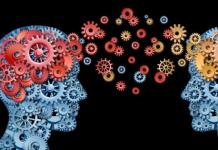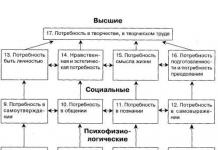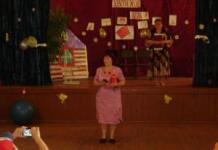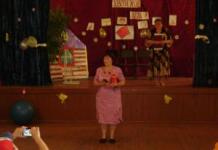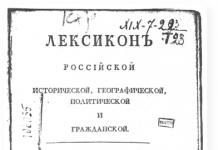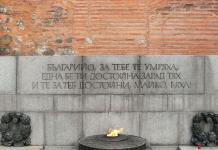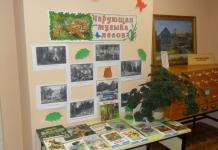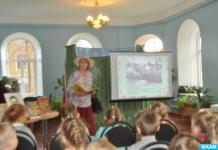Interactive technologies.
Encyclopedia of educational technologies:
In 2 volumes. T. 1. M .: Research Institute of School Technologies, 2006, 816 p.
In pedagogical practice, the term "active methods and forms of learning" has long been used. It brings together a group of pedagogical technologies that achieve a high level of object activity in the educational activity of schoolchildren.
Recently, another term has become widespread - "interactive learning". The term interactive learning refers to education based on active interaction with the teacher. In essence, it represents one of the variants of communication technologies: their classification parameters coincide. In other words, interactive learning is learning with well-organized feedback of subjects and learning objects, with a two-way exchange of information between them.
Interactive software technologies are a type of information exchange between students and the surrounding information environment. There are three exchanges of information exchange.
Extraactive mode: information flows are directed from the subject of the training system to the object of training (student), but circulate mainly around him, without penetrating into the object. The student acts as a passive learner. This mode is typical for lectures, traditional technology. This mode is most often passive, does not cause the child's subjective activity, since learning is represented mainly by the activity of the learning environment.
Intraactive mode: information flows go to a student or a group, cause them, cause their vigorous activity, closed within them. Pupils act here as subjects of teaching themselves, teaching themselves. This mode is typical for technologies of independent activity, self-study, self-education, self-development.
Interactive mode: in this case, information flows penetrate into consciousness, cause its active activity and generate a reverse flow of information, from student to teacher. Information flows, thus, either alternate in direction, or have a two-way (counter) character: one flow comes from the teacher, the other from the student. This mode is typical for interactive technologies.
The simplest examples of interactive technology are conversation or consultation. Most of all, the interactive mode is presented in technological methods included in any specific mono-technology.
Target orientations:
§ activation of individual mental processes of students;
§ excitement of the student's internal dialogue;
§ ensuring the understanding of the information being exchanged;
§ individualization of pedagogical interaction;
§ withdrawal of the student to the position of the subject of training;
§ achieving two-way communication between teacher and student.
The most common task of the facilitator in interactive technology is facilitation (support, facilitation) - guiding and assisting the information exchange process:
§ revealing the diversity of points of view;
§ an appeal to the personal experience of the participants;
§ support for the activity of participants;
§ combination of theory and practice;
§ mutual enrichment of the experience of the participants;
§ facilitation of perception, assimilation, mutual understanding of the participants;
§ encouraging the creativity of the participants.
Features of the organization.
Information should be assimilated not in a passive mode, but in an active one, using problem situations, interactive cycles. Interactive communication promotes mental development. In the presence of feedback, the sender and recipient of information change their communicative roles. Feedback greatly improves the efficiency of the exchange of educational information, allowing both parties to eliminate interference.
Interactive technologies are based on the direct interaction of students with the learning environment. The learning environment acts as a reality in which the student finds himself as an area of mastered experience, and this is not just about connecting his empirical observations, life impressions of the student as an auxiliary material or illustrative addition. The learner's experience is the central activator of learning cognition. In traditional teaching, the teacher plays the role of a "filter" that passes educational information through himself, in interactive teaching - the role of a helper in work, one of the factors that activates directional information flows.
In comparison with the traditional one, in interactive learning models, interaction with the leader also changes: his activity gives way to the activity of students, the task of the leader is to create conditions for their initiative. In interactive technology, students act as full-fledged participants, their experience is no less important than the presenter's who not so much provides ready-made knowledge as encourages an independent search.
The teacher performs in interactive technologies in several main roles. In each of them, he organizes the interaction of participants with a particular area of the information environment. In the role informant - expert the teacher presents the text material, demonstrates the video sequence, answers the questions of the participants, monitors the results of the process, etc. In the role organizer - facilitator he establishes the interaction of students with the social and physical environment (breaks down into subgroups, encourages them to independently collect data, coordinate assignments, prepare mini - presentations, etc.). In the role consultant the teacher turns to the professional experience of the participants, helps to look for solutions to the already posed problems, independently set new ones, etc.
In some interactive technologies, the presenter does not need to be a specialist in the subject. The disadvantages of the facilitator role include the high costs of the teacher in preparation, the complexity of the precise planning of the results, and the high energy consumption of the facilitator.
Sources of interference in interactive mode can be:
§ language (in verbal or non-verbal form);
§ differences in perception, due to which the meaning in the processes of encoding and decoding information may change;
§ differences in organizational status between the facilitator and the student.
Examples of interactive technologies:
1. Technology "Development of critical thinking through reading and writing"
2. Technology of conducting discussions
3. Technology "Debate"
4. Training technologies
|
") if (js> 11) d. write (" "; Md. write (My); // ->
TVER STATE TECHNICAL UNIVERSITY e-mail: |
The creation of so-called Virtual simulators is a new way in solving the problem of organizing educational laboratories for the study of complex measuring equipment and instruments. This problem is especially relevant in the study of medical technology due to the high cost of equipment. The main advantage of using Virtual Simulators is that you can create systems that do not exist in reality. That is, systems consisting of elements that are currently inaccessible for connection, located in different parts of the country or only abroad. Types of virtual simulators. According to the functions performed, the virtual simulators can be divided into groups: 1. Knowledge training simulators - Electronic textbooks (EU). Due to the widespread use of multimedia (graphics, animation, sound), the effectiveness of training is significantly increased. Modern technologies make it easy to supplement the mathematical formulas present in ET with "pop-up" tips, and graphic illustrations - with contextual explanations. 2. Control simulators - testing programs designed to test the student's knowledge on the topics of laboratory work. They can be used for self-study or for obtaining a theoretical work permit. The tests can include questions that allow you to establish the student's readiness for meaningful work with the simulator. To enhance the controlling effect, the results of passing the tests are evaluated in points, the student is told the number of passed tests and the amount of penalty points. To minimize guessing the answers, the program blocks the display of information with the result of each individual test. 3. Skill training simulators - multimedia animation simulators designed to simulate changes in the states of physical equipment (devices, devices) under various conditions, creating the illusion of actions with physical equipment. Their main feature is the most complete reproduction of the appearance of physical devices (front panels, scales, arrows and other elements of indicating and recording devices) and their control elements (buttons, toggle switches, switches), as well as the movement of individual elements in accordance with the user's actions based on creating animation objects and complex scenes. The student gets the opportunity to examine in detail the technical device, get acquainted with its details, as well as perform a limited set of actions related to disassembling or adjusting the device. It should be noted that a full-fledged Virtual Laboratory must necessarily include simulators of all the listed types. Basic principles of developing virtual simulators. An effective virtual simulator requires a user-friendly environment in which the user can easily navigate by focusing on the training material, test questions and operating procedures rather than managing the simulator program. Based on the available experience, several basic rules can be distinguished when developing an ES: 1. Mandatory use of frames. Dividing the screen area into several independent windows allows you to solve navigation problems, simplify the search for the necessary information for the user, and more effectively organize the dialogue (contextual tips, notes, help). It is desirable that the structure of frames does not change significantly in the course of work, since the flickering of frames on the screen will tire the user and confuse him. 2. It is necessary, if possible, to reduce the scrolling. It is better to divide the material into chapters; to view each chapter, the user should not spend a lot of time. Illustrations, photographs, animation clips must be of such a size that they fit entirely on the screen. 3. Reading a large amount of text from the screen tires the eyes, so the text can be duplicated with sound. This is especially convenient in relation to email. diagrams: instead of skimming from picture to description, the user can study the diagram by listening to the explanations to it. The Tver State Technical University has developed a Virtual Laboratory, which includes an electronic textbook, a testing program and a multimedia virtual simulator. The program can be used to conduct laboratory work and test students 'knowledge, but is more focused on students' independent work. |
|||||||
|
document. write ("= 0)) (document. write (" codebase = "http: /// java / netscape3" ");) else (if (((parseInt (navigator. appVersion))> 3) || (navigator. userAgent. indexOf ("MSIE 4."))> = 0) (document. write ("codebase =" http: /// java / 400 "");) else (document. write ("codebase =" http: / // java / netscape3 "");)) document. write ("CODE =" jspylog. informer. Informer. class ""); document. write ("width = 149"); document. write ("height = 20> "); document. write (" "); document. write (" ") Copyright © "CCTO-Tver" |
End of form
|
|||||||||||||||||||||||
|
POSSIBILITIES OF INTERACTIVE LEARNING TOOLS
MOU "Secondary school number 30", Osinniki, pos. Robin
The modern era is the information era. Today, the decisive role in the social success of a person is played by his possession of information and knowledge. Perhaps the most important problem in connection with the constantly growing volume of knowledge acquired by mankind is how to preserve, select and transfer this knowledge from generation to generation.
The learning process at school is directly related to the ability of students to use information technology, work on a computer, the Internet and select the necessary information. Computer training programs, training systems based on multimedia technologies, intelligent and training expert systems, and communication tools have proven themselves positively in the educational process.
In traditional teaching, the main active (in terms of feedback) participants in educational information interaction are two components - the trainer and the learner (learner). When using a learning tool operating on the basis of ICT, an interactive partner appears for both the learner (learner) and the learner, as a result of which the feedback is carried out between the three components of educational information interaction. The role of the educator as the only source of educational information that has the ability to provide feedback is changing (shifting in the direction of supervision or mentoring). The time previously spent by the educator on retelling the teaching materials is freed up for solving creative and managerial problems. The role of the learner is also changing. The student moves on to a more complex path of search, selection of information, its processing and transmission.
Interactive learning tools are a means in which a dialogue occurs, that is, an active exchange of messages between the user and the information system in real time.
The emergence of interactive teaching aids provides such new forms of educational activities as registration, collection, accumulation, storage, processing of information about the studied objects, phenomena, processes, transfer of large enough amounts of information presented in various forms, control of displaying models of various objects on the screen, phenomenon , processes. Now an interactive dialogue is carried out not only with the training, but also with the training tool, operating on the basis of ICT.
The leading goal of using multimedia equipment in the classroom is to achieve a deeper memorization of educational material through imaginative perception, enhance its emotional impact, and ensure "immersion" in a specific socio-cultural environment. It does this through the use of a multimedia projector, an interactive whiteboard and a computer with Internet access.
At present, the hardware and software of a computer has reached such a level that it has become possible to implement an electronic textbook on its basis, which has a number of advantages over a printed product. These advantages are due to the use of a new generation of multimedia, hypertext, interactivity in an electronic textbook.
Multimedia. Multimedia is a complex of computer hardware and software that allows you to combine information presented in various forms (text, graphics, sound, video, animation), and work with it interactively.
In an ordinary textbook, all information is presented only in the form of text and graphics. In an electronic textbook, you can effectively use all the variety of multimedia technologies.
Firstly, the text of an electronic textbook can be made bright, colorful, with font highlighting by type, color, size, type of presentation (regular, bold, italic, with underlining). There are rich opportunities to form text and mathematical formulas in a single style, using many different alphabets (Cyrillic, Latin, Greek, etc.), special characters, pictograms.
Secondly, it is easy to create various graphic images (figures, photographs, tables, graphs of any shape, histograms, three-dimensional images). All this can be animated, that is, set in motion, change shape.
Thirdly, you can use a background soundtrack or a sound signal when referring to a certain block of information, a picture, a control button, etc. You can insert sound clips in offline or interactive mode, and sound dynamic processes.
Fourthly, video clips can be used in the same variety of ways, including video material prepared for the needs of education in previous years and saved on magnetic media and photographic films.
Fifth, multimedia technologies allow using animation, "animate" pictures, texts and other objects of the textbook. This technology makes it possible to demonstrate experimental work on objects in a virtual form, "show" invisible or conduct experiments that are dangerous for live demonstration.
Multimedia facilitates the memorization process, makes the lesson more interesting and dynamic, creates the illusion of co-presence, empathy, contributes to the formation of voluminous and vivid ideas about the past.
Hypertext. Unlike ordinary text, which is always linear (the meaning of the text is revealed sequentially), hypertext is a set of separate blocks of text (nodes), interconnected through hyperlinks. The diagram shows the structure of normal text and hypertext.
Hypertext implements a non-linear way of organizing and displaying text. In this case, the reader has the opportunity to independently choose the paths to obtain the information he needs. It is assumed that this method of obtaining information is more efficient than the linear one (used in the classic textbook).
The open structure of hypertext construction has the following characteristics:
ü nodes (blocks) of information have different sizes;
ü the network principle is supported by the structure of links;
ü the ability to explicitly represent the structure of information through the structure of the hypertext;
ü dynamic control of information by the user, when the user decides where to go through the hypertext;
ü multi-user access to information - all elements of hypertext are available to many users at the same time.
Interactivity... considers three forms of interactivity:
1. Reactive interactivity: students respond to what the program presents to them. The sequence of tasks is very strict and the individual impact on the program is very small (linear learning model). The student can freely move forward or backward through the application, choosing topics of interest to him, but the content cannot be changed. Applications of this type can be useful as a demonstration or initial acquaintance with the material being studied;
2. Effective interactivity: students control the program. They decide for themselves whether to perform tasks in the order suggested by the program or to act independently within the application (non-linear learning model). Applications of this type use hypertext markup and have the structure of electronic reference books, encyclopedias, databases, etc. The nonlinear learning model helps users to carry out self-learning according to individual educational trajectories, to vary various educational strategies. At the same time, the teacher does not give the students the necessary knowledge, he only provides support for educational strategies and assistance in finding information and understanding students of their own actions. The non-linear model is effective for distance learning;
3. Mutual interactivity: the student and the program are able to adapt to each other, as in the virtual world (“Guided Discovery” model). The model allows the learner to conduct research, overcoming various obstacles, solve individual problems, and structure the sequence of tasks. Content is often provided by motivational, playful, competitive, exploratory elements. Examples of applications of this type are adventure games in history, biology, geography, etc., simulators, workshops, educational programs, etc.
Within these three models, the level of control on the part of the student and on the part of the program is different. At the reactive level, the student's behavior is determined by the program. At the effective and especially mutual levels, control and manipulation are in the hands of the user. Interactivity contains a wide range of possibilities for influencing the course and information content:
ü linear navigation on the screen using vertical scrolling;
ü hierarchical navigation using hyperlinks;
ü online help function. Most effective when adapted to instant information presentation;
ü feedback. The reaction of the program, which gives an assessment of the quality of the user's actions. This reaction is displayed if the further course of the program's development depends on this assessment;
ü constructive interaction. The program provides the ability to build objects (targets) on the screen;
ü reflective interactions. The program stores individual student actions for further research.
Interactive board.
Smart Board interactive whiteboards provide teachers and students with a unique combination of computer and traditional methods of organizing educational activities: they can be used to work with almost any software and simultaneously implement various methods of individual and collective, public ("answer at the blackboard") student work.
The main form of presentation of materials for demonstration to the class is a presentation, consisting of a set of slides. The main tool for creating such presentations is usually Microsoft PowerPoint. However, SMART Notebook environment provides even more options that are specifically designed for working with your interactive whiteboard.
Drawings can not only be created by yourself, inserted from external files from disk, but also taken from the built-in fairly rich collections.
SMART Notebook software can be installed and used on any computer - even without connecting the whiteboard to it. This allows the teacher to prepare all the necessary materials for the next lesson at home.
You can call the student to the blackboard and, giving him an electronic marker instead of a traditional chalk, instruct him to solve the problem by completing the necessary drawings and entering the required letters, numbers and other symbols using the virtual keyboard or handwriting recognition tool. At the same time, it is much easier for the student to draw regular geometric shapes, it is more convenient to supply them with the required signatures, all calculations can be checked immediately, if desired, using the standard Calculator application from the Windows kit, and the dirt from chalk and a wet rag that have become habitual will forever be a thing of the past.
The common goal of different teaching methods and types of lessons is the assimilation of knowledge by students. At the same time, the introduction of innovations is encouraged, so that they fit harmoniously into the already established structure of the lesson. Learning models are divided into passive, active, and interactive.
Classification of learning models
Passive the model (extractive mode) assumes the activity of the learning environment. This means that the material is assimilated by students from the text of the textbook or from the words of the teacher, there are no creative tasks and communication between them. A prime example of such a model is a lecture or a traditional lesson. This model is used quite often, despite the fact that modern requirements for the structure of the lesson imply the use of active methods that would cause the child to be active.
Active the model (intraactive method) is characterized by stimulating the independence of students and stimulating cognitive activity. In such a model, creative assignments (usually homework) and compulsory communication between teacher and students are encouraged. But it also has disadvantages, for example, the student acts as a subject of learning for himself, teaching only himself, who does not interact at all with the participants in the educational process, excluding the teacher. That is, the direction of this method is one-sided, aimed at independent activity, self-education, self-study, self-development; but it does not imply interaction in groups and the ability to share experiences.
Currently, it is widely used interactive teaching, such as is based on active interaction with the teacher. In essence, this is one of the options for communication technologies, since their classification parameters coincide. In interactive learning, a well-organized relationship, a two-way exchange of information, arises between the subject and the learning object. Interactive learning technology is the organization of the learning process in such a way that in it the student participates in an interaction-based, mutually complementary, collective learning process.
Application of the interactive model
The purpose of the interactive model is to organize a comfortable learning environment when all students actively interact with each other. When organizing interactive learning, they simulate life situations, use role-playing games, solve questions based on an analysis of the situation and circumstances. Therefore, the structure of an interactive lesson is significantly different from the structure of the usual one, which means that it requires the experience and professionalism of the teacher. The structure of the lesson is based on the elements of an interactive learning model - interactive technologies that make the lesson interesting and rich.
It is permissible to use interactive work in the classroom, where the mastering of the presented new material takes place, in the lessons where knowledge is applied, in special lessons, as a generalization or survey. At the initial stages of training, work in pairs is quite effective. Its huge advantage is the opportunity to speak out to each child, to exchange their own ideas with a partner, and then voice them to the whole class, and most importantly, every student will be involved in the work.
The main requirements that ensure the success of learning using interactive technology are:
- A positive relationship in which there is an understanding by all members of the group that the shared learning activity will benefit each student.
- Direct interaction, in which all members of the group are in close contact with each other.
- Individual responsibility, in which each student must study the proposed material and be responsible for helping others (more capable students do not do someone else's work).
- Development of teamwork skills, that is, students master the interpersonal skills that are necessary for successful work (planning, distribution, questioning).
- Job Evaluation, in which a dedicated time is allocated for the group to assess the success of their work.
 Implementation of an interactive model in the lesson
Implementation of an interactive model in the lesson
Interactive technologies allow students to play various personal and job roles in the educational playing field, to master them when creating a future model of human interaction in an industrial situation. When using interactive technologies in teaching, the student is as close as possible to the conditions of the educational material, is included in the studied situation, is encouraged to take active actions, experiences a state of success and motivates his behavior.
As part of the lesson, the interactive model can be implemented using the following interactive technologies:
- Works in small groups - 2,3,4 people.
- Exercise "Carousel". Students are divided into two equal groups, one of which is the inner circle and the other is the outer circle. In this case, the students sit facing the members of the other circle, forming pairs with them. The teacher sets the topic for discussion and roles, for example, the outer circle of students is the audience, who can ask clarifying questions, and the inner circle is the storytellers who answer the questions. Every 2 minutes, the teacher gives a command, and the outer circle moves one person to the side, thereby changing pairs, while the members of the circles change roles among themselves. In this way, you can discuss no more than 3 topics at a time, and it is imperative that they have a positive orientation, for example, student achievements.
- Lectures with problematic presentation, in which a problematic situation for students is modeled, and it is assumed that they will find a new way to solve it, since the student cannot solve the situation using the known one.
- Lesson-seminar (debate, discussion).
- A heuristic conversation, in which the teacher does not communicate ready-made knowledge to the students, but with correctly asked questions allows them to approach new concepts on the basis of existing skills and knowledge.
- Lesson conference.
- Lesson using multimedia.
- Modeling technology.
- Full collaboration technology.
Interactive game
One of the most productive pedagogical technologies is an interactive game that creates optimal conditions for self-realization and development of students. Its purpose is to change and improve the models of activity and behavior of subjects of pedagogical interaction, and their conscious assimilation of these models. Interactive games stimulate activity and social development, create a magical world where everyone accepts its laws and regulations. Children do not hide their emotions, communicate freely with the participants in the game using verbal and non-verbal methods, make decisions, try different roles.
During the game there is interaction, which supports the development of personality and socialization, allows you to determine the development and integration of those knowledge and skills that students already have. Active participants in the game study more intensively, motivate themselves more, but those who focus on the leader - on the contrary. Interactive games help children to quickly establish contact with each other, the game helps to increase the rate of reaction, makes it possible to express their emotions, both negative and positive. The list of themes for interactive games is endless: exploring your body, seasons, colors, mood illustration, mutual feelings, friends or family, home or school, gifts. Also, games can take place as genre performances, improvisations.
The main directions, according to which the game situations are realized during the lesson, are as follows:
- The didactic goal is set in the form of a game task;
- Educational activities are carried out according to the rules of the game;
- Educational material is used as a means of play;
- The element of competition is included in educational activities, and the didactic task becomes playful;
- A successfully completed didactic task is associated with the results of the game.
In order to correctly combine the elements of play and learning, to determine the place and role that are assigned to game technologies in the educational process, the teacher must understand the classification and functions of pedagogical games. There are four main traits such games:
- direct and indirect rules;
- rivalry and emotional elation of activity;
- active, improvisational, creative nature of the activity;
- free developmental activity, which is undertaken only at the request of the child.
Didactic play is one of the most effective ways to awaken a keen interest in the subject being studied. The desire to play inherent in children must be used, directed to the solution of various educational and educational tasks. For the game to be interesting and accessible to children, the teacher must think over and prepare it well, the rules of the game must be clear and concise. How effective the game will be depends on the teacher's interest and emotional attitude to the game, the course of its development and the result. How effective a didactic game will be depends on how systematically it is used, what is the purposefulness of the game program.
A business game is an activity in which various practical situations are imitated. Game technology involves game modeling, when a mock is created that replaces a real object in a situation, when mockups are manipulated to replace real experiments with artificially constructed patterns of behavior. The rules of the game can be taken from a real situation or be invented.
During business games, the participants form different positive attitudes:
- Interest in activities and problems that are modeled and acted out in the course of the game;
- Assimilation of a large amount of information, which contributes to the creative search for solutions to problems;
- The ability to adequately analyze the real situation;
- Formation of objective self-esteem of students;
- Development of analytical, innovative, economic and psychological thinking.
For a business game to give the desired result, it must be based on theoretical knowledge, ideas about the field of activity that is being imitated.
Since one of the fundamental principles of the educational process is humanistic, you should pay attention to the fact that the goal of education should not be the assimilation of a certain amount or set of knowledge by a child, but the holistic development of his personality. The means of personality development, capable of revealing its potential abilities, is independent thinking and cognitive activity. Hence the conclusion - the teacher should set himself the task of ensuring such independent and mental activity in the lesson, and this is facilitated by interactive technologies, in which the student independently opens the path to knowledge, and the assimilation of knowledge is the result of his activities.
15 minutes
Part 1. Using an interactive learning model
Speech by the presenter (head of the educational organization or his deputy). After the expressed theses, the participants discuss important points and debate.
Thesis 1. New forms and methods of working with students are needed
Leading:
Federal Law of December 29, 2012 No. 273-FZ "On Education in the Russian Federation" contains a definition of the concept of "upbringing" - it is "activities aimed at personal development, creating conditions for self-determination and socialization of the student on the basis of socio-cultural, spiritual and moral values and rules and norms of behavior in society in the interests of a person, family, society and state. "
In the Federal State Educational Standard of Basic General Education, approved. by order of the Ministry of Education and Science of Russia dated December 17, 2010 No. 1897(as amended on 31.12.2015, hereinafter referred to as the FSES of basic general education), the following features of educational work are approved:
- orientation to the ideal;
- value judgments;
- following a moral example;
- dialogical communication with significant others;
- identification;
- poly-subjectness of education and socialization;
- joint solution of personally and socially significant problems;
- systemic activity organization of upbringing.
It is necessary to choose new methods and forms of work with students. There is a need for interactive technologies aimed at:
- on the development of the student's communicative culture;
- ensuring the conditions for its effective socialization;
- personality development;
- education of personality in situations of communication and interaction of people with each other.
Thesis 2. Technology is a tool for the teacher's professional activity
Leading:
The success of the implementation of the goals and objectives determined by the FSES of basic general education depends on the close interaction of teachers and parents of students. It is necessary to apply new technologies not only in educational activities, but also in working with their parents.
What is pedagogical technology?
Participant:
Strictly scientific design and accurate reproduction of the pedagogical actions guaranteeing the success.
Leading:
The teacher is required to be able to organize his impact in such a way that his end result is personal interaction at the pedagogically optimal level. The technology applied in this case should be optimal from the point of view of the influence of the teacher on the students, to form their value attitudes towards the world.
The central component of technology is a clearly defined end goal built on a diagnostic basis. An accurate definition of the final and intermediate goals allows you to develop an optimal algorithm for achieving them, select tools for tracking planned results and, if necessary, make step-by-step adjustments. Technology is a tool for a teacher's professional activity.
Pedagogical technology is distinguished by:
- concreteness and clarity of purpose and objectives;
- the presence of stages: primary diagnosis; selection of content, forms, methods and techniques for its implementation;
- the use of a set of means in a certain logic with the organization of intermediate diagnostics of the achievement of the goal, criterion assessment.
Thesis 3. An interactive model of education and upbringing focuses on the personality of the child
Leading:
In modern pedagogy, the most significant types of technologies include technologies of personality-oriented education and training of schoolchildren. Their guiding principle is taking into account the personal characteristics of the student, the individual logic of his development. In the process of teaching and upbringing, you need to focus on children's interests and preferences in the content and types of activities. Pedagogical activity with a focus on the student's personality naturally contributes to his prosperous existence, and therefore health.
What learning models are used in pedagogy?
Participant:
There are several models of education:
- passive - the student acts as an “object” of learning (listens and looks);
- active - the student acts as a "subject" of learning (independent work, creative tasks);
- interactive - inter (mutual), act (act) - the learning process is carried out in conditions of constant, active interaction of all participants in educational relations; the teacher and the student are equal subjects of the educational process.
Leading:
An interactive model of teaching and upbringing is an imitation of life situations, the use of role-playing games, project activities, and the joint resolution of problem situations.
Interactive technology is a holistic system that covers a specific part of the educational process. It includes sequentially games and exercises that form the personal qualities of students, which ensure the effectiveness of entering society, their self-realization in accordance with interests and opportunities.
The advantages of interactive, including gaming technologies:
- activation and intensification of educational relations;
- creation of interpersonal interaction;
- making collective decisions in various situations simulating real conditions;
- flexible combination of various techniques and methods of work;
- the ability to simulate almost any type of activity.
What are the principles of interactive learning and education.
Participant:
Dialogue interaction; work in small groups based on cooperation and collaboration; active role playing and training forms of work.
List interactive forms and methods of work.
Participant:
Discussion: dialogue, group discussion, analysis of situations from practice, analysis of situations of moral choice, etc.
Game: didactic and creative games, including business / management games, role-playing games, organizational and activity games.
Training: forms of conducting classes (communication trainings, training of sensitivity), which can include discussion and play teaching methods.
Leading:
In the extracurricular activities of students, interactive technologies can perform the following functions:
- value-orientational (translation of social norms for solving urgent problems of social interaction);
- individual orientation (self-determination in status and function in social interaction);
- instrumental-orientational (gaining experience of orientation in various social situations);
- the function of self-realization (getting pleasure from the process of interaction, realizing one's own capabilities and needs);
- stimulating (motivation to participate in extracurricular activities, to achieve success, to analyze and reflect on one's own behavior);
- constructive, diagnostic and corrective.
At today's pedagogical council, held in the form of an organizational-activity game, we have to develop a set of conditions that ensure the effectiveness of the use of interactive technologies in the activities of our school.
25 minutes
Part 2. Organizational-activity game
It is useful to play the game with parents of students at parent-teacher meetings and with high school students at classroom hours, and discuss the results at the pedagogical council.
Leading:
Break into 4 equal teams: administration, teachers, parents, students. Assignments have been prepared for you, where questions are indicated from the standpoint of four social groups.
The game will start on all teams at the same time. 15 minutes are given for reflection.
After completing the first task, the teams change places ("move" to the next social group), etc. You must play the roles of representatives of each social group.
The results of the discussion of issues in each group are recorded, then collectively discussed, analyzed, and corrected.
Leading:
Now let's start developing a system for the organization's activities to introduce interactive pedagogical technologies.
Participants summarize the results of the game. The expert group selects the most acceptable options for solving the problems posed and prepares the decision of the pedagogical council.
Leading:
The Pedagogical Council decides:
- In order to master modern interactive pedagogical technologies for teachers, the methodologist should develop and conduct theoretical and practical lessons with the team.
- To generalize the experience of teachers who effectively use interactive pedagogical technologies in working with students and their parents.
- A psychologist to organize individual and group consultations, the purpose of which is to correct the activities of teachers to introduce interactive technologies into the educational process.
- Administration to develop and provide organizational and pedagogical conditions that provide opportunities for the use of interactive pedagogical technologies in the educational space of the school.
- To create a new organizational management structure in the educational organization, ensuring the inclusion of teachers and parents of students in self-government activities within the framework of the use of interactive technologies.
- Class teachers at parent-teacher meetings to familiarize students' parents with the results of the pedagogical council.
- To the deputy heads of the educational organization for educational and educational work to create a bank of interactive pedagogical technologies for working with parents and students, taking into account age characteristics and various directions of educational activities.
Revealing the conditions for the effective organization of the educational process using interactive methods, it is important to recall the words of A.N. Leontyev, who argued that any activity is mediated by a person's relationship to other people. The author of the theory of contextual learning A.A. Verbitsky concludes that "any objective action takes place in a social context, is socially conditioned, involves the participation of other people and their response, personal and social responsibility for what is done." Therefore, it is important for a teacher to operate not only with the subject-technological component of his activity, but also with its social context. With regard to social interaction, G.M. Andreeva notes the activity of each side. The leading side is often called "initial" and the second is reactive. But since the state of each of the parties is active, then the one who is outwardly passive (reactive) carries out the action of accepting-not accepting the influence of the active party, making a decision about participation-non-participation in joint activities. These provisions allow us to make an unambiguous and simple conclusion that, in the educational process, the teacher assumes responsibility for the student's acceptance of the impact and his participation in the planned activities.
The deepest and most complete is the systematization of the main types of intersubjective interaction that determine the structure of D.A. Leontyev. YES. Leontiev considered all practical implementation in the educational process, revealing a variety of situations of interaction. In his opinion, the scheme of subject-subject interaction is incomplete, since in the philosophical understanding the subject exists only in opposition to the object. Therefore, it is important to see the subject of the interacting people and transform the scheme into "subject-object-subject". Individual human activity, being collective in origin, transforms a linear scheme of interaction into a jointly distributed, cooperative, in which subject-subject interaction acts as a form of coordination and integration of individual actions of the participants.
Such activity has a common not only operational, but also a motivational and semantic structure.
IN AND. Panov, performing a psychological analysis of pedagogical activity, also proceeds from the paradigm of "subject-subject" relations in the educational process. According to this paradigm, the main attention is paid to the learning activity of the student, the task of the teacher is to organize the learning activity so as to achieve the objectives of the lesson. Note that in modern pedagogy, the methodology of working in this paradigm has not yet been developed and presents significant difficulties for the teacher. The main difficulty in implementing the subject-subject approach is that the teacher must set a goal that must be accepted by the student. Only by accepting the goal, the latter turns into a subject of educational activity. Each of the components of the structure of a lesson, lesson is influenced by external conditions (in relation to the teacher, these are the states of students, characteristics of the external environment, events occurring in the micro and macrosociety) and internal conditions, which are determined by the teacher's ability to assess the situation and make a decision adequate to external conditions. their actions. That. the teacher must be competent in the field of professional activity, i.e. ready for the manifestation of knowledge, skills, abilities and personal qualities that allow successfully solving functional tasks that are the essence of professional activity. However, the question remains as to how much the position of the subject is formed in the teacher himself. The teacher purposefully implements his professional activity in the form of certain professional competencies (actions), and the unit of analysis and the criterion for the formation of professional pedagogical activity is the formation of the teacher's subjectivity, i.e. the formation of his ability to be the subject of pedagogical actions.
IN AND. Panov emphasizes that in order for pedagogical activity to acquire the highest form of its development - the form of pedagogical activity, this stage-by-stage formation is necessary.
- Stage 1. Ability to perceive and form an image (perceptual model) of the required action. At this stage, the subject must develop a perceptual model, the subject examines, listens, peers, a perceptual, conceptual model of what needs to be done is formed. In other words, there is a perceptual internalization of the sample action. There is no monitoring function.
- Stage 2. Performing an action through imitation without monitoring the correctness of its implementation. This is the stage of development of the subject of reproductive reproduction, the subject of imitation. At this stage, the principle of assimilation to what a person sees as a model for reproduction is implemented. The means for control is a perceptual model of what needs to be done.
- Stage 3. Execution of a sample action with external control over the correctness of this execution. This stage is characterized as the stage of apprenticeship (student position), when the subject is able to voluntarily perform the required action, but with external control over the correctness of the performance, which is carried out by the teacher (external locus of control). This is the stage at which the process of internalization begins again, but the internalization is no longer so much of the action itself as the function of monitoring the correctness of the performance of this action.
- Stage 4. Reproduction of a sample action in the presence of subjective, internal control (the internalized control function, i.e., voluntary regulation, is a stage in the development of the subject of voluntary performance of an action under internal control, when, performing the required action, the subject himself is able to assess the correctness of his performance of this action (position master).
- Stage 5. The implementation of external control of the educational activity of students, when the object of this control is educational actions (the exteriorized function of voluntary regulation) - this is the stage of development of the subject of exteriorization of control, the subject of expert assessment of the correctness of performing the required action by other individuals (the position of an expert). The subject returns to the situation where the action took place. In this case, there is an exteriorization of both the executive and the regulatory (controlling) aspects of the action required to be performed.
Based on this model, it follows that the ability to be the subject of an action includes the ability not only to perform an action, but also to exercise conscious control over the correctness of its implementation. Moreover, the action is internalized first, and only then the control function. At the same time, there are two cycles of implementation of the principle of unity "interiorization - exteriorization": at the level of formation (intrinsicization) of the perceptual model and its exteriorization in the form of imitation, and at the level of formation of the function of control over the correctness of the required action and the ability to externalize it. But it is clear that a teacher becomes a real subject of pedagogical activity only when he is ready to reflect and ex- priorize the action, which occurs at the last stage.
The given theoretical model of the formation of the subject, the formation of activity to the "form" of activity is an ideal model, in reality, the identified stages (stages) of the development of subjectivity are superimposed on each other, and the formation of some of them, possibly, outstrips the development of others.
One of the determining factors for the success of pedagogical activity is the ability to develop subject-subject relations, which is also impossible without the formed subjectivity of the teacher himself.
IN AND. Panov includes relations in the system of ecopsychological interactions, which is understood as a set of human interactions with the environment and acts as a system-forming factor for the unification and development of “man” and “environment” into the systemic relation “man - living environment”. The type of interaction between the components of the specified relationship is determined by the role position of each of its components. The following six types are distinguished as basic types of ecopsychological interaction:
- - object-object, when the interaction in the "student - teacher (educational environment)" system has a purely abstract and formal character and is characterized by passivity, and in this sense, three-dimensional, on both sides;
- - subject-object, when a student, taking a passive position in the learning process, plays the role of an object of influence from the educational environment, in particular, in the form of pedagogical influence from the teacher;
- - subject-object, when the educational environment acts as an object of perception, analysis, design, examination (assessment) by a teacher or a student (possibly together with a teacher) as a subject of specified or other active actions in relation to the educational environment, its components, and subjects;
- - subjective-subjective, when the components of the "student - teacher (educational environment)" system take an active role position in relation to each other. However, this interaction can also be of different types:
- a) a subject-isolated, when each of the components takes an active position, but not taking into account and not taking into account the subjectivity of the other component. The educational situation has the character of mutual misunderstanding and even rejection of each other;
- b) jointly subjective, when the interaction of a student and a teacher has the character of a joint action, subordinate to the achievement of a common goal, but at the same time does not require a change in the own subjectivity of the interacting subjects;
- c) subject-generating, when the interaction in the system "student - teacher (educational environment)" has a jointly distributed nature, since it is subordinated to a single goal, the achievement of which is impossible without uniting its subjects into a certain subjective community. In turn, this requires from its subjects a mutual exchange of methods and operations of a jointly performed action, their appropriation (intrinsicization and expriorization) and, consequently, a change in their own subjectivity.
Thus, jointly distributed, cooperative and generating the subjectivity of its participants, the activity requires the teacher to seriously rethink the existing customary ways of implementing professional tasks in the educational process. This is important, because the main differences of the interactive learning model are, firstly, the real, and not the declared joint activity of teachers and students at all stages of the educational process; secondly, the use of the existing experience of students as a source of learning.
The core of interactive forms of learning is group work, including in small groups, which largely determines the educational effect and generates the following characteristics of joint activities:
- - high activity of all participants in the educational process, due to the presence of a single goal and common motivation; dividing the process of activity between its participants in accordance with the individual capabilities, experience and abilities of the group members; taking responsibility for the overall result;
- - the comfort of interaction generated by working in a small group. Working in a small group, the participants are more free and confident. Psychological barriers to learning are removed, everyone's opinions are accepted and appreciated by the group. Close psychological contact is established;
- - the development of personal qualities, an increase in the self-esteem of the participants in the interaction. Everyone has the opportunity to learn both the leading role and the role of an ordinary participant in a group decision situation, develop the ability to openly interact with others while maintaining their own individuality, learn to subordinate personal interests to the interests of a common cause, and build constructive communication models.
- - development of the ability to speak in front of an audience, to concisely and clearly express your thoughts.
Active and interactive methods and techniques have become increasingly included in such a traditional form of teaching as a lecture. For example, a lecture-conversation, a lecture with pre-planned mistakes, a lecture with the use of elements of "brainstorming" (brsynstorming), a lecture with analysis of microsituations imply direct contact with the audience, allow you to draw the attention of students to the most important issues of the topic, determine the content and pace presentation, taking into account the specifics of the audience, to expand the range of opinions of students, to use collective experience and knowledge. Such techniques activate the cognitive activity of the audience, make it possible to control the opinion of the group, use this opinion to change the negative attitudes and erroneous opinions of some students; lecture with intense feedback.
Summing up what has been said, it is important to emphasize that in interactive learning there are two parallel processes: mastering the content of education and the communicative process. There is no doubt that each teacher is a specialist in the content of his academic subject, but besides this, one must remember the following psychological and pedagogical conditions for achieving efficiency in educational interaction:
- 1. Creation of a favorable psychological climate, reflecting the quality side of relations and characterized by the desire for jointness, mutual assistance, the desire to achieve a constructive result, positive emotions;
- 2. Dialogue communication style, implying high personal involvement of the participants, mutual respect, equality, co-creation, active listening;
- 3. Taking into account the phases of group dynamics (the content of the concept of "group dynamics" will be disclosed in the second chapter of the manual);
- 4. Development of group interaction skills, which occurs through the organization of activities in pairs, triplets, small groups with a dynamic, changing composition;
- 5. Reflective summing up, which helps each participant to determine the personal level of advancement, and the group - to develop the rules for effective joint activities.









